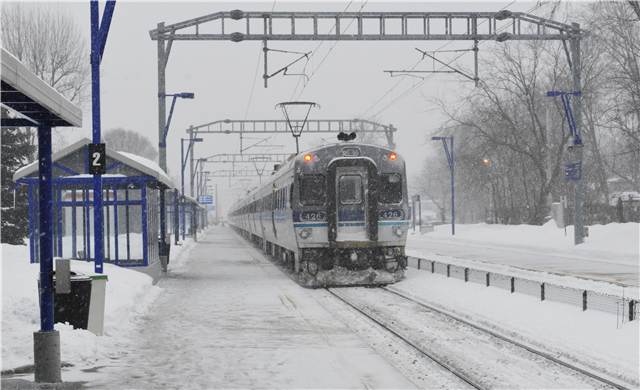Snow removal: the answers to all your questions

Snow removal has prompted many questions from our transit users. Here are the answers to 10 of your most frequently asked questions about it.
-
Who clears the snow from your sites?
Snow is removed from exo sites by private contractors hired for the winter season (November 15 to April 15).
At the end of every day, each contractor presents us with a report detailing the actions carried out on each site.
-
Which areas are cleared of snow?
Snow removal operations cover all pedestrian and vehicle traffic areas.
Pedestrian traffic areas
- Access stairs
- Fire escapes
- Access ramps for persons with reduced mobility
- Sidewalks
- Train station platforms
- Bus terminal platforms
- Transit shelters
Vehicle traffic areas
- Traffic lanes
- Parking lots
- Bus loops
-
When do you remove snow?
To ensure your safety, our facilities are cleared of snow, de-iced and spread with abrasives (salt, sand, gravel, ice melters) as soon as:
- l’accumulation de neige atteint 5 cm;
- la ligne jaune sur les quais n’est plus visible;
- les boucles d’autobus sont enneigées.
-
At what times do you remove snow?
Snow clearing operations often take place outside of peak periods:
- Daytime (outside peak periods): from 9 a.m. to 3 p.m.
- Nighttime: from midnight to 5 a.m.
-
Why don’t you remove snow during peak periods for trains?
Removing snow or spreading abrasives during peak periods could lengthen embarking and disembarking times for trains, resulting in delays.
-
Why do you block parking spots to store snow?
We store snow in certain parking spaces as they can be used temporarily or permanently while we wait for regulated snow disposal sites to open.
Temporary storage
Our crews remove the snow as soon as city snow disposal sites are opened.
Temporary storage is governed by strict regulations:
- In a parking lot, if snowfall is less than 15 cm it may be stored for a maximum of 48 hours, in which time it must be transported to a disposal site.
- If snowfall is greater than 15 cm, it may be stored for a maximum of 72 hours in a temporary area.
Permanent storage
Parking spots and remote areas on the site are used to collect snow throughout the winter.
-
Why don’t you remove snow when there is freezing rain?
When both snow and freezing rain are forecast, the snow removal crews deliberately choose not to clear all of the snow. This allows the freezing rain to stick to the snow and form a layer of ice that cracks beneath your feet. As well, when the freezing rain stops falling, this layer of ice is easier to remove.
-
Which abrasives do you use?
We use three types of abrasive:
- Salt is used on all sites, except station platforms. It melts the ice and makes surfaces grainy, which improves grip.
- Salt and gravel are used on all sites, except station platforms as they build up at the bottom of train doorways and can block the doors from closing. These abrasives are particularly effective in extreme cold.
- Magnesium chloride (MgCl2) is used on station platforms.
-
Why don’t you use salt on the platforms?
Salt damages rolling stock as well as the electrical circuits and telecom ducts located beside or near the tracks. Instead, we use magnesium chloride (MgCl2), which protects the equipment while still melting the snow.
-
Why isn’t snow always cleared from platforms with a machine?
For your safety, snow blowers are only used under the supervision of a railway employee, known as a flagman.
If a flagman is not present, abrasives may only be spread by hand or with a portable dispenser.
Want to know more about exo’s winter initiatives? Read our winter plan.
